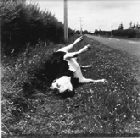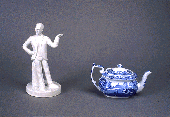 Francesco
Clemente, From Story of my life (3), Indian ink
and gouache on Orissa paper, 23.0 x 46.9 cm each, 1990
|
In 1992 Lynne Cooke, the
Artistic Director of the 10th Biennale of Sydney curated Doubletake
at the Hayward Gallery in London. Like Doubletake,
Jurasic Technologies Revenant presents a focussed
understanding of the dystopian vision which characterises
technology at the end of the millennium. And like Doubletake,
Jurassic Technologies Revenant examines a current
preoccupation with reproductive imagery and memory. As
the title of the Biennale suggests and Cooke writes in
the catalogue, the exhibition "signal the
orientation toward reproductive media whose origins
largely predate the twentieth century". Rather than
embracing new digital media and its associated hype the
curatorial focus is on more traditional reprographic
technologies. Despite the inherent problems when curating
around a particular medium and an implied nostalgia for
traditional photographic practice, Cooke’s choices
are considered, reflecting collective, social and
personal memory. |
| |
Carefully composed across
three different venues with the largest concentration of
work at the Art Gallery of New South Wales, Jurassic
Technologies Revenant is structured by a series of
enclaves or booths where, for example, Heri Dono's slide
installation examines the military presence in Indonesia.
In some cases, the works are grouped to draw out cultural
differences: Nan Goldin's slide projection of candid
interludes in Japanese clubs, Yasumasa Morimura's drag
self-portraits in which he casts himself as a movie stars
is offset by the staged vigour of Tracey Moffatt’s
group of young athletic aborginal women. For Goldin,
Morimura and Moffatt, the self is played out in a series
of controlled disguises. |
 Peter
Peryer, Dead Steer , gelatine
silver print 24.0 x 24.0 cm, 1987
|
Overall, the exhibition is
displayed according to media - textiles, readymades,
photographs and installations. One of the most
astonishing works is Ann Hamilton's installation, bearings,
which consists of a pair of slowly rotating curtains like
giant hooped skirts that extend from floor to ceiling.
Black silk organza is lined with rouched fabric, combined
in a twirling mecahnanical embrace. These sumptuous folds
of fabric are carefully positioned to intersect with the
axis of the gallery room. Nearby, a small screen set into
the wall displays images of a prosthetic arm trying to
catch a hoop. A discrepancy in scale is acted out between
the monumental kinetic component and small screen. About
automation, the prosthetic grasps while the gauze hoops
twirl. Meticulously constructed, there is an
extraordinary sensory awareness and materiality in this
work. Like a couple dancing and gliding in circles across
a dance floor, this work is a membrane marking the edge
between the inside and the outside. It is a container and
contained so that the folds of cloth envelope and seduce
the viewer. |
 Matts Liederstam, No difference at all ,
3 porcelain figures and Spode teapot, c.1816, dimensions
variable, 1996
|
Rearranging components of
the body like a 'plastic anagram' is the subject matter
of John Massey's black and white photographs. Displayed
at Artspace, the gallery was skillfully redesigned by an
architect into a series of viewing booths. The viewer
proceeds through darkened spaces to witness some of the
most compelling work. Scottish artist Douglas Gordon's 24
Hour Psycho, is a frame by frame articulation of the
Alfred Hitchcock classic that spans 24 hours while Claude
Closky's En Avant (Onward) is a rapid montage of
speed footage on video. Eulalia Valldorosa's uses the
techniques of shadow theatre to enlarge, double and
distort household objects in her installation Love's
Sweeter than Wine (Three Stages in a Relationship).
Valldorosa and the quieter works contained within
discrete architectural spaces are the most intriguing and
alluring part of the Sydney Biennale. Natalie
King
1996
|